Olfactory-related behaviour and its possible functions in a troop of free-ranging mantled howler monkeys (Alouatta palliata)
Olfactory communication
A traditional view purports that primates are primarily visual animals with a poorly developed sense of smell. However, the increasing number of studies on olfactory sensitivity and discrimination performance demonstrated that the olfactory capabilities of primates generally match those of non-primate species believed to have a keen sense of smell.
Similar to non-primate mammals, odor signals can derive from a variety of sources, such as urine, faeces, glandular exudates and saliva. Those sources of chemical signals have been found to transmit information about species, social group, sex, age, reproductive status, social rank, health status, individual identity, genetic quality, and genetic relatedness of the odor donor. The variety of information that has been identified in primate odor signals has also been demonstrated to serve different functions including the advertisement of presence, territorial defence, recognition of group members, establishment and maintenance of social rank, advertisement of sexual receptivity, synchronization or suppression of reproductive activity, establishment and maintenance of an inbreeding barrier, directed altruism, and social bonding.
Howler monkeys

Howler monkeys (genus Alouatta) are the most widespread New World primates, with a distribution that ranges from southern Mexico to northern Argentina. In Mexico, two species of howler monkeys coexist: the mantled howler monkey (Alouatta palliata) and the black howler monkey (Alouatta pigra). The Mexican mantled howler monkeys (Alouatta palliata spp. mexicana) inhabit fragmented areas in the state of Veracruz, Tabasco, Chiapas, and Oaxaca. Mantled howler monkeys live in a polygynous multi-male system in which both sexes display a dominance hierarchy, with younger adult individuals having higher ranks. Howler monkeys are considered the most folivorous of the New World monkeys, however, when available, they prefer to eat fruits. In the context of olfaction, howler monkeys are a particularly interesting genus of primates to study. They are the only New World monkeys that have developed routine trichromacy while maintaining a functional vomeronasal organ.
Aims of the study
Since the majority of the studies on olfactory social communication in nonhuman primates have been conducted on strepsirrhines and callitrichids, and since the majority of behavioural observations of olfactory-related behaviours in howler monkeys focused on the performance of one specific behaviour at a time (e.g. urine-washing), while there are only few systematic studies on chemical communication, the aims of my project were:
1- compile a complete ethogram of odor-depositing and odor-perceiving behaviours;
2- assess the frequency of occurrence of all olfactory-related behaviours;
3- discuss the possible function of olfactory-related behaviours in howler monkeys.
Responsible for this page:
Director of undergraduate studies Biology
Last updated:
05/29/17
